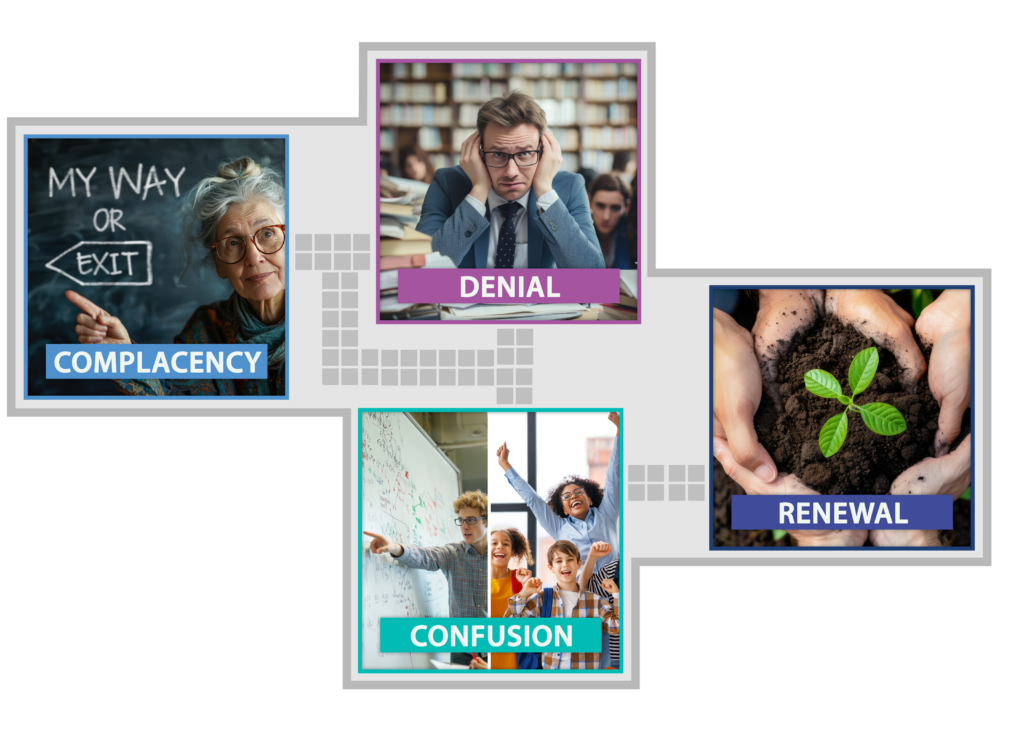Enticing Into Confusion

Any change, even for the better, is always accompanied by discomforts.
– Arnold Bennett

INTRO
Address the root causes of resistance to change. Educators’ affective needs should be met before making cognitive demands. Continuous Improvement happens when educators are open to learning, defining the desired change, understanding why the change is important, and learning how to practice the change.
OBJECTIVES
- Focus on affective before cognitive in professional learning
- Learning is challenging and requires substantial, continuous support
- Do not neglect resisters mired in the status quo
RESOURCES
- Student Experience Survey: Measuring Belonging, Connection, Engagement
- Podcast coming soon!
I was a change-oriented principal in a high school that was doing well on standard measures, but we were weak on student and family satisfaction. My vision for making the school effective for all students was grounded in educating the whole student for a meaningful post-graduation life. I couldn’t understand the forces of resistance to improving every student’s school experience. I didn’t know that my job was to shepherd my staff and community through a peculiar little four-room apartment in which many of us were wedded to the history of what the school had been while too few sought a brighter future.
No matter our instructional, distributed, or transformational leadership strengths, their value is insufficient counterweight to the change agent’s mortal enemy, the status quo. Foot soldiers in the status quo army are the purveyors of “No!” No matter how promising an idea, the answer is always the same—no.
Change Agents vs. the Resisters
When I started as a principal I had enough administrative experience to understand there would always be resisters, but I never stopped trying to understand the root causes of their resistance. I went with the old adage that, whatever you propose, a third will be early adopters, a third will be on the fence, and a third will oppose change. Twenty-five years after transitioning out of my principalship, I have come to disagree with the frequently shared advice—don’t worry about the bottom third because they will never come along. Instead, I now believe that the bottom third, if ignored, will fester, complain, and recruit allies until their numbers grow to half, then two-thirds. By that time a new innovation has come along and the old one dies an ignominious death as the battle with the status quo continues.
A different perspective is that change is a process, not an event. A school will never be “changed,” only in a state of “becoming.” This more dynamic perspective leads us to think about what fuels the change process and what saps its strength. Fuel generally comes from an inspiring vision, people who strive to achieve the vision, resources necessary to take implementation steps toward the vision, and the energy to keep moving forward. Fuel is consumed as energy is expended in good work and overcoming resistance. When the resistance becomes too great, fuel is depleted, energy is sapped, and forward motion ceases. It stands to reason that if we can minimize resistance, we can move farther forward faster.
The Four-Room Apartment
Resistance lives in a Four-Room Apartment. Imagine the Four-Room Apartment as a school striving to design students’ classroom experience for deeper engagement by following this sequence:
- Build relationships between students and teachers,
- understand the relevance of content to students’ lives, and
- drive to higher order thinking.

Let me take you through the rooms.
| The Complacency Room Here you can find the veteran teacher, successful with students who survive their classes and not very concerned about those who transfer out. Their mantra in response to any proposed change goes something like, “Yeah, we tried this in the 90s and it didn’t work so well then. Parents and students love me, so why should I change?” Right about how to reach some students, they and their colleagues are wrong to be complacent because they require students to adapt without addressing the needs of those who don’t readily comply. | The Denial Room This is where the overwhelmed teacher lives. They may be new to the profession or are not proficient and stuck in survival mode. Their response is something such as, “I’d love to try new techniques, but I have so many papers to grade and the scope and sequences for my courses are so demanding I can’t slow down. I can’t put time into relationships and relevance because I need to get my kids ready for the end-of-year exams.” The Denial Room teacher is joined by others who just can’t cope with the realities of their classroom shortcomings. |
| The Confusion Room The smiling teacher in the Confusion Room is a leader and change agent. They are trying an idea that seems super-promising. Their students are responding positively to the combination of relationships, relevance, and higher order thinking in the classroom. The teacher gesticulating at a whiteboard is an early adopter finding new techniques to achieve equitable teaching practices. These two love being in the Confusion Room with like-minded change agents and early adopters because they are gratified by the professional learning and improvement process. They may soon be in Renewal with strategies and tactics they’ve learned to rely on. And they will likely encounter new challenges that will send them back into the Confusion Room for another round of eager learning. | The Renewal Room This school is striving to achieve more equitable, life relevant outcomes for students. They want to move their whole school into the Renewal Room that represents their vision for whole-student learning and achievement. Leadership must strategize how to get everyone to Renewal. |
The gray bars are hallways in the Four-Room Apartment. Notice that the teacher in the Complacency Room and the teacher in the Denial Room could walk into each other’s rooms, and they probably often do, but they cannot get to Renewal without going through Confusion.
Why Confusion?
Because learning and trying new things causes us to be confused. This is why learning can be painful. If you put a teacher from Complacency into Confusion they are suddenly no longer in command. Whatever change is being considered will feel alien and disempowering; their old approaches won’t work. The teacher from Denial will be more overwhelmed than ever, at least at first, because they can’t even use what already isn’t working and are expected to try new things they don’t understand. Why would anyone want to inhabit the Confusion Room?
Now what?
The first step is to understand the root causes of Complacency and Denial. Removing or reducing these root causes will help entice staff into the Confusion Room.
Root Causes for Avoiding the Confusion Room
Affective
- Changing requires more work
- This school tries something new every three months and forgets about the old “great ideas.”
- I’m not wasting my time with that. I’m doing fine now; I’ll do worse if I change
- Asking me to change tells me you think I’m a bad teacher
- I’m five years from retirement; I’m tired
Cognitive
- I don’t understand what they want me to do
- I don’t know why I should make the change
- I don’t know how to make the change
A common response to this situation might be for the principal to 1) explain the mechanics and benefits of the teaching model, 2) get enthusiastic adopters to share their positive experiences and hope that others want to emulate them, and 3) push like crazy to decrease the resistance . That method might show some success in the near term, but it doesn’t address the reasons for Complacency and Denial—the root-causes for why those folks took up residency in those rooms. As the resisters wait out the change effort and others start to become disillusioned in the Confusion Room, the change agent and the early adopters get tired and retreat to their classrooms where they know they can succeed. Fuel is depleted, energy is gone, change fizzles.
Leaders can follow some steps to a better outcome. Explaining the steps is fairly simple, but carrying them out will be challenging. Separating the affective from the cognitive root causes and examining them differently helps to illuminate a more effective process.
Techniques for Addressing Root Causes
| Affective Root Causes | Leader Mitigation/Elimination Techniques |
|---|---|
| “Changing requires more work” | Acknowledge the truth of this statement and follow up with, “What are some ways we can lighten the load?” Be prepared with time and monetary resources, but let staff tell you what they need and want. |
| “This school tries something new every three months” | Don’t do that! Acknowledge past mistakes and make a long-term commitment to the change you are advocating. If you can’t make that commitment comfortably, don’t attempt the change. You’re not ready or it’s not good enough. |
| “I’m fine now, I’ll do worse if I change” | Maslow’s Hierarchy helps us to understand this concern. This person is actually telling us something such as, “I’ve got pretty good esteem going with my colleagues, students, and parents and there are days I’m self-actualizing. I don’t want to mess that up.” Working with this perspective means providing authentic esteem (recognition) for taking risks in the Confusion Room and focusing on process instead of outcomes. When people feel as though they are meeting professional ideals through a learning process, the outcomes will follow. Emphasizing outcomes too soon has many bad effects, one of which is to diminish motivation. |
| “You think I’m a bad teacher” | Maslow again. The tricky move is to acknowledge past good work to keep the person at the esteem level while encouraging them to take their skills and knowledge to new heights that will address new challenges and achieve self-actualization. |
| “I’m five years from retirement” | The best we might hope for is minimizing this person’s drag on the system. Finding a role for this person that is least damaging and minimizes public complaint and negativity is a good place to start. If it can be somewhat renewing for the near-retiree, so much the better. |
TIP
Addressing these and other affective factors requires a deep understanding of each school staff member. Other toolkit items can help you get there.
I’ve presented the affective reasons first because I believe you need to have people affectively ready to make change before they can engage in the cognitive work needed to improve their practices. Think about the truth of that statement for students and you might agree with how it applies to adults. The cognitive side is actually easier. This approach requires believing that adults can learn and improve and that there are no limitations on their intelligence.
Mitigation Techniques to Address Cognitive Root Causes
| Cognitive Root Causes | Leader Mitigation/Elimination Techniques |
| I don’t understand what they want me to do | First determine if this is true or merely a statement of learned helplessness. If the latter, go back to the Affective table and figure it out. Otherwise, work with your team on a professional learning plan that focuses on everyone learning the what and the why before asking for any action in classrooms. Take a stance that you don’t want anyone attempting something in front of students they do not fully understand. Think about how this portion of professional learning might generate eagerness to take action. |
| I don’t understand why I should make the change | The “why” question splits into two halves: 1) why this and 2) why me/us? Both should be figured out before the change is ever talked about. Data and research can help. Why build relationships as part of the learning process? Because Dewey and contemporary brain research agree that learning is more engaging and occurs at a higher level when it happens in a positive social setting. That’s a “this” answer. The “me/us” answer derives from local data. Collect, analyze, and present data that show which students are engaged in higher order thinking, which are missing out, and the consequences of complacency and denial. |
| I don’t understand how to make the change in my classroom | How to make the change is the essential learning that takes place in the Confusion Room, and this is the only room in which it will happen. |
TIP
Use this toolkit to help you collect, analyze, and present data
Conclusion
The leader’s job is to entice people from Complacency and Denial into Confusion. Once there, the Confusion Room experience should be energized by camaraderie, high quality professional learning, support for those who falter, and constant feedback on progress toward Renewal. In other words, if you want to transform every student’s learning experience, plant yourself in the Confusion Room until Complacency and Denial are empty and Renewal is nearly full.






Responses